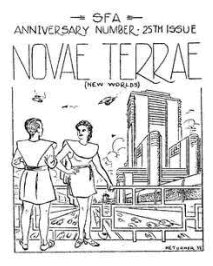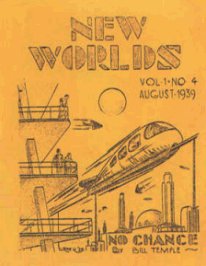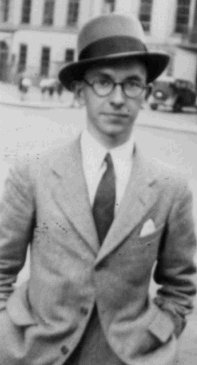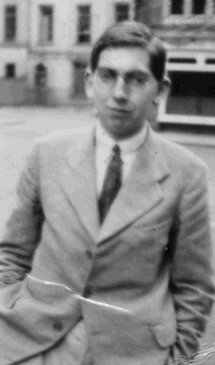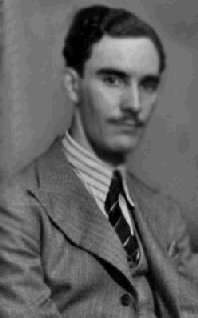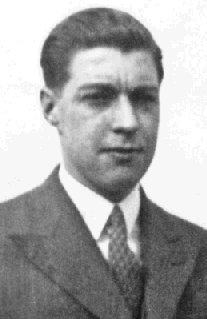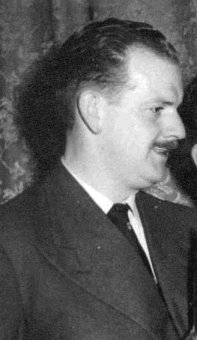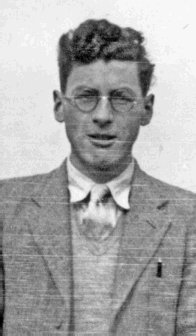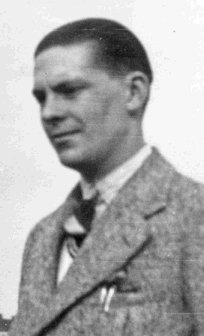NEW WORLDSThe story of the prozine NEW WORLDS is well-known and has been told many times. Perhaps less well-known is the story of the fanzines that were its ancestor publications, and of the beginnings of Nova Publications, the company British fans and pros created to ensure the continuation of NEW WORLDS when it looked as if the magazine was dead. That story is told further down the page. Directly below this are links to online copies of the fanzines and of the various founding and other documents pertaining to Nova Publications. (Note: although it doesn't pertain to the period covered on this webpage, here's a link to the Hansard entry covering the questions asked about the Arts Council grant in 1968.) FROM NOVAE TERRAE TO NOVA PUBLICATIONSIn May 1934, Hugo Gernsback and Charles D.Hornig at WONDER STORIES launched the Science Fiction League. Any fan able to find a minimum of two others in his town or city with whom to form a club could then apply for that club to become a chapter of the SFL. Five of those chapters would be in the UK. The first of these was in Leeds, which became Chapter no.17, on 1st April 1935. This was soon followed by a Belfast chapter, Chapter no.20, while in June the third UK branch of the SFL, Chapter no.22, was launched at Nuneaton by Maurice K.Hanson and Dennis A.Jacques who became its Director and Assistant Director respectively. Other members were J.E.Barnes, M.Crowley, P.W.Buckerfield and, later, D.R. Smith. (The other two chapters - 34 & 37 - were in Glasgow and Barnsley.) In March 1936, Hanson and Jacques published the first issue of the fanzine NOVAE TERRAE as the journal of Nuneaton SFL. It was the UK's first ever fanzine.
In August 1937, Hanson moved to London and the August-September issue, the 16th, was the last with which Denny Jacques and other Nuneaton/Leicester fans had any involvement. NOVAE TERRAE #17 (Oct 1937) lists Ted Carnell and Arthur C. Clarke as 'Associates'. They remain listed thus until issue #25 (August 1938), when they were joined by Bill Temple. This would be Carnell's final issue, after which only Clarke and Temple were so listed. The reason for this reshuffle was that at their invitation Hanson moved from his flat in Russell Square to 'the Flat', the famous fannish abode at 88 Gray's Inn Road that Clarke and Temple had moved into in June. (Reports of its demise to the contrary, the building is still there as of 2010 though the pub a few doors down that was the first in which London fans gathered on Thursday evenings - the Red Bull - was destroyed during a bombing raid in 1941.)
NOVAE TERRAE #29 (January 1939) was the final issue, the strain of producing a monthly-to-bimonthly publication that ran from twenty to forty-eight pages finally proving too much for Hanson, even with on-site assistance from Temple and Clarke. In his editorial, Hanson announced he was handing the reins over to Ted Carnell, whose first issue, with new numbering and retitled NEW WORLDS (the anglicised form of 'Novae Terrae' that had often appeared on the cover or title page of that fanzine), would be appearing the following month, though in the event it was actually published in March. It saw four issues in all, the final one in August. Its cessation was due to the entire Science Fiction Association being suspended - somewhat prematurely - "for the duration" with the outbreak of war in September. That suspension turned out to be permanent. That should have been the end of NEW WORLDS, but in fact next chapter in the story happened barely a month later. Bill Passingham, a professional journalist and SFA member Carnell had first met at the 1938 convention, approached him in October 1939 with the news that he had interested a publisher in the possibilities of a British science fiction magazine. A number of meetings were held with the publishing company, the second on 5th January 1940 with Walter Gillings in attendance, and it was agreed that Carnell and Passingham would put up £50 each. It was also decided that the magazine should be called NEW WORLDS. On February 13th the directors of the company gave a luncheon at the 'Savage Club' to celebrate completion of the initial work and to finalise details of the launch. There were other details as well, as Carnell later related:
"Plans were also discussed for a possible collaboration with the SFA, the suggestions including two separate kinds of membership, one including a year's subscription to NEW WORLDS and SFA membership, the other as associate member at five shillings entitling members to all the privileges planned around the magazine -- co-operation with cinema clubs and special tickets for members when SF films were being shown; a yearly free gift to all members of the 'best' SF book of the year; the formation of a SF circulating library; a monthly printed fan magazine covering news about the genre in general. All very grandiose considering that we now had a war in Europe!"Two weeks later the bubble burst. The publishing company's directorate split, funds mysteriously vanished, wages were not paid, and by the end of March the company had gone into liquidation, leaving Carnell sadder, wiser, and £50 poorer. For Carnell's news release about this at the time see here. The last week of January 1946 was typically cold and bleak. Ted Carnell had been demobilised from the Army the previous week after five-and-a-half years service and had just visited his pre-war employer in Holborn only to find that the printing department where he'd worked had been fire-bombed out of existence. Walking down Fleet Street, contemplating his next move, he met Frank Arnold who was then working for The News-Chronicle. It was a chance encounter that was to have many repercussions for British fandom. (Arnold's own recollection is that the meeting was arranged and took place at Charing Cross, but in both accounts what happened thereafter is the same.) Arnold had made contact with Stephen D.Frances (aka Hank Janson) of Pendulum Publications and interested him in putting out an SF magazine, and now having met up with Carnell, who Arnold thought the ideal man to edit it, they hurried along to Lincoln's Inn and the offices of Pendulum on the top floor of 10 Old Square. Based on his plans for the aborted 1940 version Carnell was given carte blanche to edit and produce the first two issues of NEW WORLDS, if possible on a quarterly basis. As the first issue began to take shape Ken Chapman came out of the Navy and Carnell arranged to meet him at The Shamrock in Fetter Lane (owing to the beer shortage they were allowed only a half-pint each on that occasion). Discussing the plans for the new magazine Chapman suggested they arrange a monthly meeting of their pre-war colleagues as this would give Carnell an opportunity to talk to them about his editorial requirements. In March those who turned up at The Shamrock included Maurice Hugi, Hal Chibbett, Bill Temple, Fred Brown, Eric Williams, Alan Deveraux, Frank Arnold, Ken Chapman, and several others. The following month this group moved across the road to The White Horse, whose accomodations were larger and supply of beer more generous. In effect these meetings were friendly out-of-the-office editorial conferences with a largely professional interest that led, in July 1946, to the appearance of the first issue of NEW WORLDS. However, within months of the meetings starting Ted Tubb learned of them and spread the word among the capital's fans. Seeing in the meetings a chance to recapture the pleasant atmosphere of those pre-war days of the Flat and the Red Bull, they began turning up as well, and in rapidly increasing numbers. Soon these Thursday night meetings were being held weekly. By the end of the year those showing up at the meetings also included Arthur C.Clarke, A.Bertram Chandler, and John Beynon Harris, and the group had started calling itself the London Circle. Unfortunately, the immediate post-war period was to prove an inhospitible one for new magazines and NEW WORLDS ceased publication in October 1947 after only three issues when its publisher ceased trading. The WHITCON, Britain's first post-war convention and the one from which the national convention is numbered to this day, took place on Saturday 15th May 1948. It was put on with little advance publicity but still succeeded in attracting 50 attendees, quite good for those days, and was held in the The White Horse. Ted Carnell's own speech to the convention included news of NEW WORLDS. He told them that since the magazine had folded because Pendulum Publications went under and not through any fault in NW (the third and final issue had been over-sold by 3000 copies), it still had a future. The paper situation meant that he couldn't approach another publisher to take over NW, but a few days before the convention he had discussed the possibility of forming a company to finance the magazine with Gillings, Ken Chapman, and Eric Williams. This idea was greeted with great enthusiasm by those present and was to develop further in the months that followed.
Following the convention Carnell continued to discuss his ideas with this group and with John Beynon Harris, but printing and distribution remained major problems. Then, in July, Vince Clarke brought along a newcomer to the White Horse. This was Frank Cooper, an ex-RAF officer who was not only a fan and reader of many years standing but a bookseller and librarian with a London shop of his own - the Fantasy Book Centre - then in Stoke Newington, but later to relocate to the far more central Sicilian Avenue. In one evening of discussion with Cooper, Carnell and his group had sorted out the distribution problems, and with a second they were ready to go ahead and form their company. In September, in the fifth issue of OPERATION FANTAST, Carnell announced that the company would have share capital of £800 and that they were looking for shareholders at £5 a time. So it was that Nova Publications was formed, a fan-financed company that had John Beynon Harris as President and Carnell, Gillings, Chapman, Williams, and Cooper as Directors. On 9th December a letter was sent to investors informing them that the company had been incorporated, and that final documentation was awaited before they could proceed with the allotment of shares, which was to take place at a special meeting of the Directors. NEW WORLDS was duly re-launched in February 1949, with Carnell once again its editor. ............(c) Rob Hansen (most of the above was taken from THEN.)
|
||||||||||
|
The story of Nova Publications, its rise and fall, is told in the documents that
can be found following the link at the top of the page.
|
